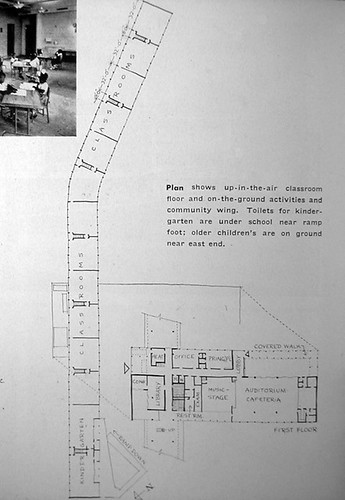 Thomy Lafon Elementary School, originally uploaded by regional.modernism.
Thomy Lafon Elementary School, originally uploaded by regional.modernism.The form of the school has been obscured / marred by the unsympathetic addition of those horrible corrugated red hoods. But the plan better illustrates how this school functioned without corridors. The kindergarten wing was accessible by a playful ramp to the upper story. Beyond the kindergarten, classrooms were paired to share a staircase and toilet facilities. Architect Nathaniel C. Curtis described the plan as "the next logical step after the finger plan."* His partner architect Arthur Q. Davis describes the form as "a long, thin classroom wing, gracefully bent to avoid monotony."**
Here the pilotis serve many functions. The elevation of the classroom wing amplifies available play space which also offers shelter from rain and needed shade.This would also keep the classrooms cooler as there is a greater breeze at higher elevation. This is of course an old French Colonial tradition. Finally, the pilotis saved the classrooms from flooding post-Katrina. The Survivors Council fought to re-open the school in 2007, but to no avail. It has remained shuttered. The RSD has no plans for the reuse of the building. However, it could be adapted to serve the Harmony Oaks community as an early childhood center.
* In 1952 the first modern school was built in New Orleans, designed by Curtis and Davis. It was originally known as McDonogh 39 (later renamed Avery Alexander School) and followed a finger school plan with a series courtyards between the wings. School Facilities Plan called for its demolition. It was on the Louisiana Landmark's New Orleans Nine Most Endangered list in 2009, along with Lafon, Wheatley and Carver. Quote is from Talk About Architecture, Heard, Lemann and Klingman, 1993
** It Happened by Design, Arthur Q. Davis, 2009
No comments:
Post a Comment